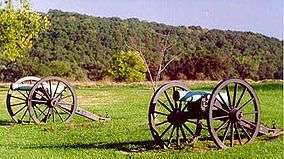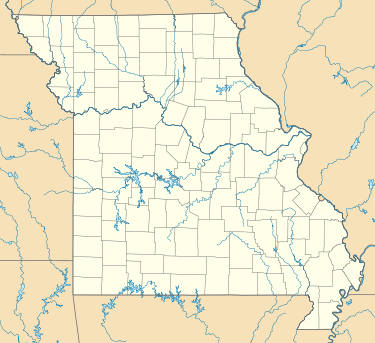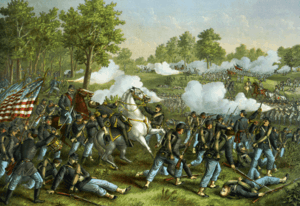Wilson's Creek National Battlefield
| Wilson's Creek National Battlefield | |
|---|---|
|
IUCN category III (natural monument or feature) | |
 | |
 | |
| Location | Brookline Township, Greene County, Missouri, USA |
| Nearest city | Republic, Missouri |
| Coordinates | 37°6′56″N 93°25′12″W / 37.11556°N 93.42000°WCoordinates: 37°6′56″N 93°25′12″W / 37.11556°N 93.42000°W |
| Area | 1,749.91 acres (7.0816 km2) |
| Established | April 22, 1960 |
| Visitors | 160,000 (in 2014) |
| Governing body | National Park Service |
| Website | |
|
Wilson's Creek National Battlefield | |
  | |
| Nearest city | Springfield, Missouri |
| Area | 1,750 acres (710 ha) |
| Built | 1861 |
| NRHP reference # | 66000113[1] |
| Added to NRHP | October 15, 1966 |
Wilson's Creek National Battlefield at 6424 West Farm Road 182 near Republic, Missouri, preserves the site of the Battle of Wilson's Creek. Fought on August 10, 1861, it was the first major American Civil War engagement west of the Mississippi River. The Confederate's failure to exploit their victory here resulted in keeping Missouri in the Union. Major features include a 5-mile automobile tour loop, the restored 1852 Ray House, and "Bloody Hill," the scene of the major battle. The site is located just southwest of the city of Springfield, in southwestern Missouri.[2]
Battle at Wilson's Creek

The Battle of Wilson's Creek, also known as the Battle of Oak Hills, was fought on August 10, 1861, near Springfield, Missouri. Union forces were striving to defeat the Missouri State Guard and preserve Missouri for the Union, along with St. Louis, a major port on the Mississippi River. It was the first major military engagement west of the Mississippi river. It was a Confederate victory but ultimately a strategic failure.[3]
Wilson's Creek National Battlefield Park
The battle site was established as Wilson's Creek National Battlefield Park on April 22, 1960, and was redesignated a National Battlefield on December 16, 1970. The battlefield was listed on the National Register of Historic Places on October 15, 1966.
The park is open seven days a week from 8 a.m. to 5 p.m. The visitor center and contains exhibits about the battle, a short film, fiber optics maps and a bookstore. The visitor center offers brochures about the 5-mile self-guided tour of the battlefield.
All park facilities are closed Thanksgiving Day, Christmas Eve, Christmas Day and New Year's Day.
The park is accessed by a 5-mile long self-guided automobile tour loop. There are eight stops at significant battle-related locations on the tour road which give access to walking trail.[3] There are five walking trails off the tour road, varying in length from 1/4 to 3/4 of a mile. A seven mile trail system for horseback riding and hiking is accessible from the tour road. Reenactments and cannon firings are frequently held for visitors.[4]
The anniversary of the battle is observed with special programs on August 10.[4]
The Wilson's Creek Civil War Museum (formerly the General Sweeny Museum), contains artifacts and exhibits relating to the war west of the Mississippi is located in the visitor's center.[5]
The 1850s Ray House is a historic house museum that was the site of a temporary field hospital for Southern soldiers after the battle. It is the house where General Nathaniel Lyon's body was carried after the battle. The house is open on weekends in the summer, with volunteers dressed in period clothing giving tours.[4]
The Civil War Trust (a division of the American Battlefield Trust) and its partners have acquired and preserved 272 acres (1.10 km2) of the battlefield, most of which has been sold to the National Park Service and incorporated into the park.[6]
The Hulston Library
The John K. and Ruth Hulston Civil War Research Library was founded in 1985. In April 2003. A new library building was dedicated. Most of the library's collection was donated by attorney John K. Hulston and his wife Ruth. The library contains approximately 10,000 volumes on the Civil War period and the Civil War in the Trans-Mississippi Theater. The library's volumes are non-circulating and can only be viewed on-site. Staff members are able to perform limited research for patrons by and extensive research is done in person.
The library has electronic access to the National Archives Compiled Service Records of all Union and Confederate soldiers. The library also has published rosters giving basic information on all Civil War soldiers.
The library contains many histories of individual Civil War regiments, especially Union units. In addition, many Northern state adjutant general's reports and other regimental materials are available. There is limited information available on Southern units. Those seeking information about ancestors can consult the Civil War Soldiers and Sailors System.[7]
References
- ↑ National Park Service (2010-07-09). "National Register Information System". National Register of Historic Places. National Park Service.
- ↑ Thomas P. Busch (March 1976). "National Register of Historic Places Inventory Nomination Form: Wilson's Creek National Battlefield" (PDF). Missouri Department of Natural Resources. Retrieved 2017-01-01. (includes 3 photographs from 1969, 1975)
- 1 2 "The National Parks:Index 2009–2011" (PDF). Retrieved October 1, 2017.
- 1 2 3 "Things To Do - Wilson's Creek National Battlefield (U.S. National Park Service)". www.nps.gov. Retrieved 2017-10-04.
- ↑ "Visit the Wilson's Creek National Battlefield". Wilson's Creek National Battlefield Foundation. Retrieved 2017-10-04.
- ↑ American Battlefield Trust "Saved Land" webpage. Accessed May 23, 2018.
- ↑ "The Hulston Library - Wilson's Creek National Battlefield (U.S. National Park Service)". www.nps.gov. Retrieved 2017-10-03.
External links
| Wikimedia Commons has media related to Wilson's Creek National Battlefield. |
- Official NPS website: Wilson's Creek National Battlefield
- Wilson's Creek National Battlefield Foundation

